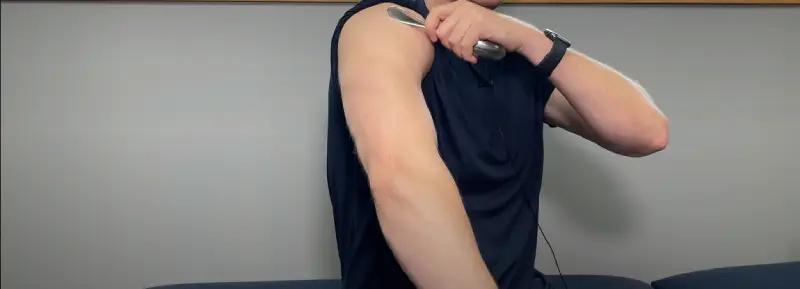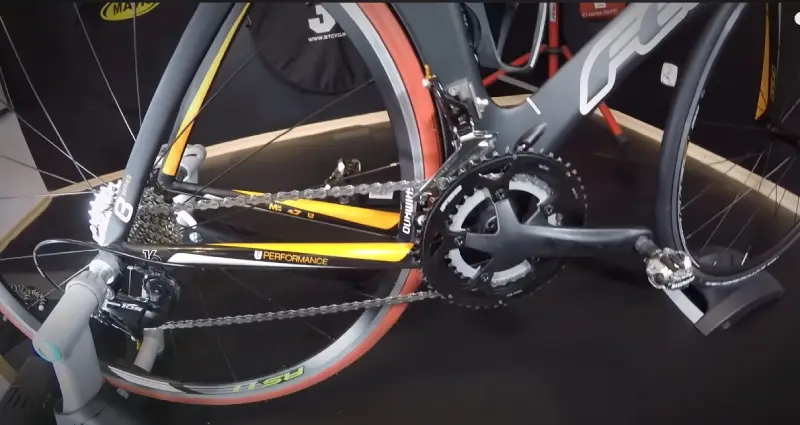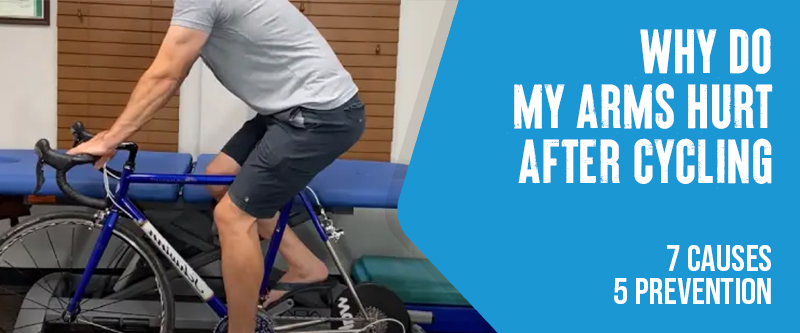Insufficient saddle lay-back shifts your center of gravity forward, increasing pressure on your arms and hands. Long bike riders may experience elbow and hand pain as they try to compensate. Over-gripping can lead to overuse injuries or compression of the ulnar nerve because of poor grip placement on the handlebars.
Excessive tilting of the wrist causes pain in the arms. This can occur because of poor bike fit, riding in the same position for an extended period, or gripping the handlebars too tightly.
In this blog post, we will explore the causes and prevention methods of arm pain after cycling.
Why Do My Arms Hurt After Cycling: 3 Muscle Solutions

Cycling can lead to body aches and pains. Arm pain is one common complaint among cyclists, and several factors, Cycling shoes with cleats too close to the inside can increase the distance between your feet, stressing the inside collateral ligaments and causing knee pain on the inner (or medial) sides.
Knee pain can also be caused by too much float in your pedals. Let’s inspect these factors and how they affect arm muscles and joints.
Posture
If your back is hunched, your arms will bear much of the weight of your upper body, which may lead to fatigue and soreness in your shoulders, neck, and arms.
- Forward Head Posture: A forward head position causes the shoulders to round forward. An upper back hunch puts pressure on the neck, shoulders, and arms.
- Slouched Back Posture: Slouched backs pressure the lower spine and core muscles, resulting in weak upper bodies. Leaning heavily on the handlebars can cause wrist pain and fatigue for the cyclist.
Handlebar Position
While cycling, the position of the handlebars can significantly affect arm pain. Too high or too low handlebars can strain the arms and shoulders, causing pain and discomfort. The cyclist should maintain a relaxed and comfortable grip on the handlebars with minimal arm strain when using a proper handlebar position.
Too much pressure on your hands can cause upper arms and neck pain. When cycling on the flat at your functional threshold power or at 85% of your maximum heart rate, you should feel almost weightless on the handlebars.
✔ Top Pick: Adjustable Stem for Bike Fit
Many people use an adjustable stem to fine-tune reach and handlebar height to reduce arm fatigue.
Improper Bike fit
Poorly fitted bikes can cause many problems, including arm pain. If your bike’s setup needs to be corrected, it can put too much weight on your arms or cause them to stretch too far out of alignment with your body.
It’s important to remember that wrist pain while cycling can be caused by your seat being too high relative to the handlebars, leading to more weight on your forearms. Gripping the handlebars too tightly, repeated hard braking, and overstretching the tendons and muscles are also common causes.
Poor Gear Selection
Cycling with the wrong gears also results in arm pain. You can suffer from soreness and pain later on when you ride in a gear that is too high. Too low a gear can also be problematic, as it causes excessive strain on your legs, resulting in an undue reliance on your arms.
Overuse of Arm Muscles
When cycling, your legs take on most of the load, but your arms play an essential role in maintaining balance and distributing body weight. Overworking your arm muscles can cause discomfort or pain if you grip or pull the handlebars too tightly.
Triceps muscles get sore because they are not used to supporting your body weight for long periods. Check your riding position to eliminate this nuisance. A long reach to the handlebar stresses and fatigues the triceps. If your reach is too short, your trapezius muscle may experience soreness. Add some triceps conditioning to your resistance training regimen.
✔ Top Pick: Triceps Resistance Bands
Many people use resistance bands to strengthen the triceps and improve arm endurance for longer rides.
Terrain
The terrain you cycle on can also affect how much work your arms must do. A bumpy ride can require upper-body control and balance to maintain balance on rough or uneven surfaces.
After exercise, it’s normal for your muscles to feel sore or stiff for a few days. This is known as delayed onset muscle soreness (DOMS) and can occur in people of all fitness levels, especially after trying a new activity or pushing yourself harder than usual.
Duration of cycling
As you ride longer, the continuous exertion can gradually lead to fatigue in your arms. Extensive holding of a position can cause your arms and shoulders to feel stiff, making the overall experience uncomfortable and potentially affecting your performance on the bike.
It’s essential to be aware of these effects and take measures to ease discomfort, such as incorporating stretching exercises or adjusting your position periodically during your rides.
Arm Pain After Cycling: 5 Prevention
While it’s normal to experience discomfort, persistent arm pain and numbness can be concerning. Prioritize proper bike fitting, ideal handlebar positions, good gear selection, regular stretching, massage, and strength training exercises for arm muscles. Stay hydrated and nourished during cycling activities.
Bike Fitting and Adjustments
Cycling can be uncomfortable and painful if your bike is not fitted and adjusted correctly. An incorrect bike fit can lead to discomfort and pain in the arm muscles and nerves. To ensure proper bike fitting and change, follow these steps:
- Test out different handlebar shapes and sizes to find the most comfortable.
- Adjust your seat height for comfortable sitting.
- Reduce wrist and hand pressure by adjusting your bike fit.
- You can reduce hand pressure by wearing padded gloves or using handlebar tape.
- Weight distribution can be ensured by setting the saddle’s fore-and-aft positions.
- Keep your grip on the handlebars naturally to avoid excessive arm strain.
✔ Top Pick: Padded Cycling Gloves
Many people use padded cycling gloves to reduce pressure on the hands and arms and prevent nerve compression.
Ideal Handlebar Positions and Postures
Handlebar position is another crucial factor in preventing arm pain while cycling. Your handlebars should be positioned so that your wrists are straight and natural. Maintaining proper bike posture will also help keep arm muscles and nerves well-rested. Here are some tips for ideal handlebar positions and posture:
- Relax your elbows and keep them slightly bent.
- Maintain a relaxed posture with your shoulders rolled back.
- Adjust the handlebar height and position to reach the controls comfortably and naturally.
Proper Gear Selection

Cycling gear selection is crucial in preventing injury to the arm. Too high a gear can stress the arm muscles and nerves unnecessarily. Here are some tips for proper gear selection:
- It is best to use the small or middle front chaining and more significant rear cog when riding uphill or into a headwind.
- Downhill, use the bigger front chaining and a range of smaller rear cogs.
- Avoid using gear that is too high for your fitness level and cycling goals.
Regular Exercises
Exercises that stretch, massage, and strengthen arm muscles can prevent pain and discomfort during cycling. Consider these routines:
- After you’ve cycled, try your hands and wrists.
- Stretch your triceps.
- Massaging your forearms.
- Exercises that strengthen the arms, such as bicep curls and tricep extensions.
Cyclist Palsy Treatment Exercise
- Exercises for bending the fingers. The first step to this exercise is to stretch your hand.
- Squeeze the finger. Hold a small object (such as a coin or a piece of paper) between two fingers for 10 seconds.
- Exercises for strengthening your grip. A weak hand grip can be improved with this exercise.
✔ Top Pick: Grip Strengthener Tool
Many people use a grip strengthener to improve forearm and hand strength and reduce discomfort from prolonged handlebar contact.
Adequate Hydration and Nutrition
The key to preventing arm pain and discomfort is to stay hydrated and nourished before, during, and after riding a bike activity. Fatigue and cramping can be caused by dehydration and poor nutrition, which stress the nerves and muscles in the arms. Some tips for staying hydrated and nourished:
- To replenish electrolytes and energy, consume a sports drink or snack.
- Support muscle recovery and function by eating a balanced diet rich in nutrients.
Conclusion
It can prevent arm pain and numbness through proper bike fitting and adjustments, ideal handlebar positions and posture, valid equipment selection, stretching, massage, strengthening exercises for arm muscles, and adequate nutrition and hydration during cycling.
Cycling techniques that maximize benefits while minimizing injury risk are the key to avoiding arm pain. To prevent further injury, seek medical attention if you experience persistent arm pain.
FAQs
Why Are Cyclists Muscular?
Cyclists who aspire to excel in sprints prioritize developing muscular arms, recognizing the advantages of upper body strength in sprinting. They strive for lean, defined muscles without hypertrophy and maintain a body fat percentage of merely 4-5%.This lean physique allows them to optimize their climbing performance, as carrying excess body fat would impede their speed on mountainous terrains.
Why Do My Shoulders Hurt After Cycling?
Make sure your bike is fitted correctly. During extended rides, you can maintain an ergonomically correct position for your arms and shoulders. Maintain a neutral posture while cycling. Don’t hunch over or maintain an aggressive posture for long periods. Regular breaks prevent prolonged strain on the body. Listen to your shoulders and rest when needed.


